Top News

October 24, 2012 Ryukyu Shimpo
On October 23, a group lobbying against the Treaty of Mutual Cooperation and Security between the United States and Japan held a rally in the Hibiya Open Air Concert Hall in Chiyoda, Tokyo, to protest against the deployment of the Osprey. About 2000 people took part in the rally despite heavy rain falling. The rally was a protest to the Government against the deployment of the MV-22 Osprey, its low-level flight training and a call for the early closure of Futenma Air Station. The organizers declared that they intend to expand their protests all over Japan.
Kazuo Shii, the chairman of the Japanese Communist Party, criticized Defense Minister Satoshi Morimoto with regard to the case in which two U.S. sailors have been charged with rape. He said, “The Defense Minister describes this crime as an ‘accident.’ This indicates that the Government of Japan has never felt any responsibility towards this matter. It is impossible to eliminate the violent crime and accidents caused by the U.S. military personnel without removing the U.S. bases from Okinawa.”
Yoshikazu Tamaki, who is an Okinawan assembly member and was the head of an executive committee of a previous rally against the Osprey deployment in Okinawa, also attended the central rally. He stated, “Okinawa people feel that the Security Treaty is what has exposed them to threats and danger. The issue of military bases cannot be resolved by Okinawans alone, and we fervently hope that many people living in the main islands of Japan will join us in looking for a solution.”
Participants in the rally chanted slogans and held up posters on which they’d written “No Osprey” as they marched from the park to the National Diet Building.
(English translation by T&CT, Lima Tokumori and Mark Ealey)
Go to Japanese
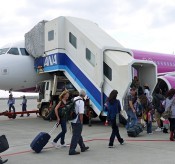
October 19, 2012 Ryukyu Shimpo
On October 18, Peach Aviation, a low-cost company (LCC) related to All Nippon Airways (ANA), based at Kansai Airport, began a Kansai-Naha route. The terminal for LCC established within the ANA cargo terminal at Naha Airport also officially started. It is a one-story building with about 3000 square meters of floor space. A total of three LCC companies: Peach Aviation, AirAsia Japan and Jetstar Japan currently use Naha Airport.
Peach uses the 180-seater Airbus A320 as their main airplane. Fares range between 4590 yen and 14790 yen one-way from Kansai Airport to Naha Airport (tax included). On the first day, the aircraft operated at 89% of seating capacity on the flights departing from Kansai to Naha, and 72% from Naha to Kansai.
They aim to increase the number of passengers on the Kansai-Naha route to 300000 in 2013 and to run at 75% of seating capacity. Peach currently operates two round-trip flights a day, but will change this to three round-trip flights per day between January 21 and March 30, 2013. They will consider increasing the number of flights depending on demand in the future.
Shinichi Inoue, the head of Peach Aviation, held a press conference at the LCC terminal in which he stated, “We will offer cheaper fights so that students and people from Okinawa living in Kansai can return to Okinawa easily. Using new aircraft for all flights, we will run these flights safely.” With regard to future plans, he said that he would like to transport many tourists to Okinawa rather than to resorts in foreign countries. Also he mentioned that in the 2013 fiscal year, they plan to start domestic and international flights from Okinawa as their second base of operations.
They have been operating with five airplanes but will increase that to ten airplanes by August 2013.
(English translation by T&CT, Lima Tokumori and Mark Ealey)
Go to Japanese
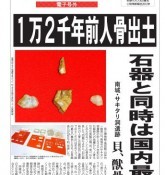
October 19, 2012 Ryukyu Shimpo
In the morning of October 19, the Okinawa Prefectural Museum & Art Museum announced that they had found human and boar bones and tools made of quartz and shellfish in the 12000 year-old layer of the Old Stone Age in the Sakitari Cave Ruins in Nanjo. According to museum staff, this is the first time that human bones and tools from the Old Stone Age have been discovered in the same ruins, and this is the oldest case in Japan.
Since the discovery of the Minatogawa-man, human bones of the Old Stone Age dating from 18000 years ago have been discovered, no other human bones have been found in the period through to the time of the ceramic culture of the Jomon Period of 7000 to 6000 years ago. This discovery will help fill in the gap between these two eras in Okinawa.
The items discovered were the canine tooth of a child, three tools made of quartz, two shellfishes, not originally from the ruins and a piece of boar bone that looks like a leftover from a meal. It is the first discovery that clarifies that quartz was used in Okinawa as a tool, and so it is expected that similar examples will be found in the future.
The Sakitari Cave Ruins in Tamagusuku, Nanjo, are located near where the Minatogawa-man was discovered. The excavation began in 2009 and the museum found the ruins between July and August in 2011, and since then its staff have been trying to ascertain what era the items are from.
Museum staff commented, “This gives us a glimpse of human culture in the Old Stone Age.”
(English translation by T&CT, Lima Tokumori and Mark Ealey)
Go to Japanese

October 22, 2012 Ryukyu Shimpo
On October 21, the final of the 52nd Miss International was held at the Budokan in Naha. Ikumi Yoshimatsu, 25, from Saga Prefecture, won Miss International 2012, ahead of 68 other beauty contest candidates from 80 countries and regions. This was the first time that Miss Japan has been chosen as Miss International, and with this Yoshimatsu became the “goodwill ambassador of beauty and peace.” She also won the Miss Photogenic award decided by a vote among members of the media.
Miss Finland, Viivi Suominen, 25, came second and Miss Sri Lanka, Madusha Mayadunne, 25, came third. Miss Haiti, Anedie Azael, 24, won the Miss JOICEF award for putting forward the best idea and concept for charity.
After the event, Yoshimatsu said, “I did not think that I would be able to win against Westerners who excel in terms of body shape, and so, all I could do was try to make the most of the good things about me to win, and so I focused on what I said. Women are going to be the opinion leaders of the next generation, so I talked about myself and what kind of activities I like.”
The beauty contest candidates came to Okinawa on October 1 and experienced aspects of Okinawan history and culture, interacting with people in the local community as they lived together. This event was held in Okinawa for the first time in 37 years since 1975, when Miss International held as part of the Okinawa Ocean Exposition, and on this occasion it was held to commemorate the 40th anniversary of Okinawa’s reversion to Japanese sovereignty. The organizers stated that as many as 2700 people packed the venue to watch the final.
(English translation by T&CT, Mark Ealey)
Go to Japanese

Go To Video
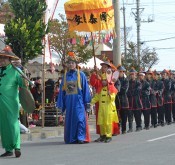
October 14, 2012 Ryukyu Shimpo
On October 7 at Tomimori in Yaese, a full moon festival was held in the square in front of the local community center. The town’s intangible cultural heritage, Tunchu junei (Chinese parade) and Yamatonchu junei (Japanese parade) were performed.
The daytime program included a michijune. Led by duru (flag holders) with flags wishing for mutual prosperity and happiness, two parades and another intangible cultural heritage item, a female parade called a yonshi, followed. Colorful and spectacular scenes such as historical scroll paintings came after this.
Tunchu junei is thought to have been introduced by people from mainland China who lived in Kume-son, Naha during the Ryukyu Kingdom era. Along with high-pitched music from the Chinese instrument, the gaku, the parade walked with “a u” (elderly nobleman in old Chinese) at its head. People dressed as soldiers in black costumes performed karate in front of the king wearing his crown.

On October 7 at Tomimori, Yaese Town, people dressed in Japanese costume paraded in the Yamatonchu junei.
The
Yamatonchu junei seems to have originated from the
Edo nobori or the delegation to
Edo, and the daimyo procession and composed. Participants in the procession marched in Japanese dress holding a sword, a gun, or a lantern in their hands.
Mari Tokashiki, who studies ethnology at Okinawa Kokusai University said, “It is my first time to see this, but I really enjoyed the story behind it. I think that it is great that so many young people took part in the parade.”
(English translation by T&CT, Megumi Chibana and Mark Ealey)
Go to Japanese
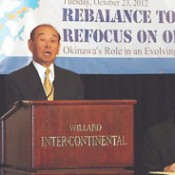
October 24, 2012 Hideki Matsudo of Ryukyu Shimpo reports from Washington D.C.
In the morning of October 23, the Okinawa Prefectural Government held a symposium in Washington D.C. to discuss the U.S. Marine Corps Air Station Futenma relocation issue. In his opening speech, Governor Hirokazu Nakaime stated, “I think that moving the Futenma base to another area of mainland Japan is a way to resolve this quickly. The Okinawan people are keen to fix this problem.” The governor addressed experts from the United States and Japan, officials of both governments and an audience packed into the conference room, emphasizing that Futenma Air Station should be relocated outside Okinawa and that the land used for the base should be returned to its owners as quickly as possible.
With regard to relocation plan for the facilities at Futenma to move to Henoko in Nago, which was reaffirmed at the Japan-U.S. agreement in April this year, the governor stated that the mayors of 41 municipalities opposed the current plan. Stressing that the option of relocating Futenma Air Station outside the prefecture will be the solution, he went on to say, “Okinawa already has too many bases as it is. The problem will not be solved if the government moves them within Okinawa. The planned move to Henoko involves delicate issues such as the impact on the natural environment. There are many airfields in the Japanese mainland that have runways,” In addition to the governor, Patrick M. Cronin, a senior advisor of the Center for a New American Security, Michael O’Hanlon, a senior fellow at the Brookings Institution, Narushige Michishita, an associate professor at the National Graduate Institute for Policy Studies and Akio Takahara, a professor at the Graduate School of Law and Politics, University of Tokyo, took part in the symposium. Mike Mochizuki, a professor of the George Washington University, served as a facilitator.
O’Hanlon pointed out that the relocation of Futenma Air Station to Henoko is impossible in the current political climate. He suggested the idea that involves building small helipads in the Northern Training Area and Camp Schwab and transferring most of the Marine Corps troops in Okinawa to bases in California, rather than to Guam. He emphasized that this would be a solution.
Jim Webb, U.S. Senator (D-Va.) and a member of the U.S. Senate Armed Services Committee, in his keynote address, again indicated that he is skeptical about the possibility of the Henoko plan working. In September 2011, when Nakaima attended at the international symposium entitled the “Okinawa Question: Regional Security, the U.S.-Japan Alliance, and Futenma,” which was held in Washington D.C., he made his first plea for the relocation of the Futenma base outside of Okinawa Prefecture.
(English translation by T&CT, Mark Ealey)
Go to Japanese

October 24, 2012 Hideki Matsudo of Ryukyu Shimpo reports from Washington D.C.
In the afternoon of October 22, at the U.S. State Department in Washington D.C., Governor of Okinawa Hirokazu Nakaima met with Kurt Campbell, the assistant secretary of state for East Asian and Pacific affairs, and Mark Lippert, the assistant defense secretary for Asian and Pacific security affairs. At the meeting, with regard to the U.S. Navy sailors being accused of raping an Okinawan woman, the Governor said, “Even if the Okinawan people have not necessarily agreed with the U.S. military presence, to date they have never done anything like throwing stones at American soldiers. We have been the victims of one-side suffering in the relationship with the U.S. military.” He urged high-ranking U.S. government officials to enforce the law more effectively and to prevent the occurrence of incidents.
The Assistant Secretary of State apologized to the Governor, saying that on behalf of the U.S. government he wants to convey feelings of apology, sorrow and deep concern. The Assistant Secretary of Defense mentioned the idea of implementing restrictions on the family members of U.S. military personnel. Nakaima requested the relocation of U.S. Marine Corps Futenma Air Station outside of Okinawa, including a review of the deployment of the Osprey vertical take-off and landing transport aircraft.
In the morning of October 23, the Okinawa Prefectural Government held a symposium in Washington D.C. to discuss the Futenma relocation issue. In his opening speech, the governor stated, “Moving Futenma out of Okinawa will help bring about an early resolution.”
After his meeting with high-ranking U.S. government officials, Nakaima said to reporters, “I told them that the Okinawan people are very angry, and that this rape incident will have a serious effect on the U.S. military presence.” He indicated that the upswell in feelings about incidents such as this case of rape could lead to a popular movement demanding the removal of U.S. bases.
According to Susumu Matayoshi, the head of the Executive Office of the Governor, who also attended the meeting, Campbell told the Governor that he had received instructions from Secretary of State Hillary Clinton to report what had been discussed at the meeting, and he promised to do everything he can to prevent recurrence of incidents. The Assistant Secretary of Defense also said that they were working to strengthen the Japan-U.S. alliance and want to deal fairly with Okinawa. In addition, he said that they were considering new measures to prevent recurrence of crimes.
Nakaima requested a statement in writing on five issues, including the relocation of Futenma Air Station outside the prefecture, a review of the deployment of the MV-22 Osprey vertical take-off and landing transport aircraft, the reduction of noise pollution from Kadena Air Base, the revision of the U.S.-Japan Status of Forces Agreement and substantial progress in reducing U.S. military facilities south of Kadena. These are included in what the Okinawa Municipal Council for Military Land Conversion and Base Problems has requested to the governments.
Campbell promised to hand over the request to Secretary Clinton, but he did not give any further details. After the meeting, the governor said he asked the U.S. government for specific answers.
(English translation by T&CT, Mark Ealey)
Go to Japanese
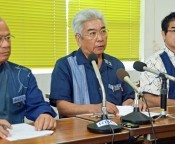
October 19, 2012 Ryukyu Shimpo
With regard to the sexual assault case against two U.S. sailors, representatives of the municipalities, political parties and civil groups protested on October 18 to the agencies of the governments of Japan and the United States, and to the U.S. military authorities in Okinawa. At a press conference held after the heads of the various municipalities in central Okinawa visited the headquarters of the U.S.
Navy Fleet Activities Okinawa, Urasoe Mayor Mitsuo Gima, who is the president of the Organization of the Central Region Municipalities, stated, “This case is both inexcusable and brutal. If we do not go as far as removing the bases, we cannot get to the root of the problem.” He has called for action to be taken towards the removal of the bases.
At the meeting of the municipalities’ representatives on October 18, the mayors adopted a letter of protest to the governments and the military authorities. The letter demands drastic revision of the Status of Forces Agreement between Japan and the United States, thorough compensation and an apology to the victim and measures to prevent any recurrence of such incidents.
Mayor Gima said, “Japanese government signed the Status of Forces Agreement, so they are complicit in this situation. The heads of the ten municipalities are equally determined to press the government to take measures to rectify the situation.” The U.S. military bases are concentrated in the central parts of the main island of Okinawa, where these municipalities are located.
Six mayors of the ten municipalities took part in the protest. On the subject of the incident having occurred immediately after the Osprey deployment, Ginowan Mayor Atsushi Sakima said, “I am both indignant and outraged that this assault took place at such a time.”
That same day, Kanagawa Governor Yuji Kuroiwa said, “This is not just a matter of concern to the people of Okinawa; I too find it indeed regrettable. I want the government to come up with specific preventive measures and a fundamental solution.” In his role as the chairperson of the National Governors’ Association for Military Facilities he verbally protested to the government of Japan and the U.S. Embassy in Japan. Two mayors from Kanagawa prefecture, where Naval Air Facility Atsugi is located, have made the content of their protest letters public. The two U.S. sailors who were arrested on suspicion of assaulting a woman in Okinawa were engaged in transport operations in Atsugi, and when they committed the crime had come to work at the Kadena Air Base with work. Yamato Mayor Satoru Oki commented, “This incident will make people distrust those on the Atsugi base.” Ayase Mayor Seijiro Kasama angrily said, “I urge the U.S. military to strengthen their enforcement of the law and to improve the education of their personnel.”
(English translation by T&CT, Mark Ealey)
Go to Japanese
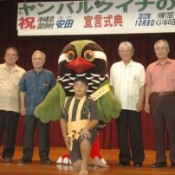
October 13, 2012 Ryukyu Shimpo
On October 8, the Ada District of Kunigami was declared as an official habitat of the Okinawan rail. The community is striving to protect the natural habitat of this rare bird.
That same day at Ada Public Hall a ceremony was held during which Ward Mayor Tanji Kamiyama stated that they would work to protect the endangered Okinawan rail. Takashi Nagamine, the director of the non-profit organization (NPO) called Dobutsutachi-no-byoin-Okinawa (Animal Hospital Okinawa), which has worked with Ada District, reported that the district’s efforts to repopulate the Okinawan rail are more advanced that other similar cases in Japan. These efforts have increased the rail’s population of around 700 in 2005, to current levels.
The chairman of the NPO Support Center for Yambaru Development, Akio Higa, stated that the local government has asked them to produce a general plan that matches the habitat declaration.
According to the Kunigami Municipal Office, they will establish an institution that exhibits pairs of Okinawan rails to promote a better understanding of the significance of the protection activities. The institution will be set up in the Okinawa Prefectural Livestock Improvement Center by the end of this year utilizing local government bonds available under the Act on Special Measures for Promotion for Independence of Under-populated Areas. Local people and tourists will then be able to observe the Okinawan rail and learn about the ecological system.
(English translation by T&CT, Lima Tokumori and Mark Ealey)
Go to Japanese

October 12, 2012, Ryukyu Shimpo
It was when Tomoko Teruya went to an exhibition on the “Manhole children” that she was inspired to do what she does now. After seeing this exhibition, she set up a non-government organization (NGO) called “Yuimaru” to support and manage an orphanage in Mongolia called “Children of the Sun,” striving to save these children so they can embark on self-dependent lives. At the Ryukyu Shimpo Office, she commented, “I want to change the situation of those children who are living in such extreme poverty and I’d like to see similar initiatives spread throughout the rest of the world.”
The exhibition was held at her old school, the Okinawa Shogaku High School. One of the pictures had words that touched Teruya’s heart: “A boy with a swollen face, bitten by a mouse.” When she read this, she felt that she must do something to help.
She went to Mongolia and visited the orphanage when she was a student at Waseda University. Reflecting back on that time she said, “The purity of the children touched me, and I decided that I wanted to dedicate my life to helping them.” In 2007, she founded the NGO and created a scholarship program to financially support the children in their future university studies. At that time, she was studying to become a lawyer in order to support them from the legal angle, but she struggled to find a balance between study and her work. That was when the Great East Japan Earthquake occurred. This disaster made her understand the unexpected ways in which life can suddenly change, and this realization led her to focus more on her work for the orphanage. She was surprised to know that when children at the orphanage found out about the disaster, within only a month, they raised six million yen and sent it to Japan. This made her feel stronger that she wanted to serve those children as much as she could.
The scholarship program has been running since 2008, and from May in 2011, they officially took over the management of the orphanage from another organization. Teruya, who was selected as one of the Global Shapers announced at the World Economic Forum in 2011, said, “Children are children wherever they may be born. I want to try to provide opportunities for them to make the most of the talent that they possess.”
A charity concert will be held on November 25 at Ishikawa Hall in Uruma. The price for tickets will be between 1000 and 2500 yen. Please call 050 (3736) 8012 to purchase tickets.
(English translation by T&CT, Kyoko Tadaoka and Mark Ealey)
Go to Japanese

October 16, 2012 Ryukyu Shimpo
For two and a half hours in the afternoon of October 15, two MV-22s flew a total of 12 times over densely populated areas such as Naha and Urasoe in the southern and central regions of Okinawa. By October 6, the U.S. Marine Corps completed the deployment to Futenma Air Station from Iwakuni in Yamaguchi Prefecture of 12 MV-22 Osprey vertical take-off and landing transport aircraft.
The Osprey’s flight over urban areas in helicopter mode and the convertible mode is restricted under the agreement of the Joint Committee, but has been confirmed as occurring numerous times. The Marine Corps has continued its MV-22’s flight operations despite their violating the agreement. Some residents also saw the MV-22s’ flight training for the first time, taking off from Futenma Air Station and flying towards the western coast and then back to Kadena Air Base.
The flight path confirmed this time was that the aircraft took off from Futenma Air Station towards Kitanakagusuku, and then flew along the coast and offshore in the south, finally coming back to Futenma over the cities of Naha and Urasoe. In addition, the flight path in the direction of Kadena Air Base has been confirmed as the aircraft passing over the Kadena Ammunition Depot towards the west coast, then entering Kadena Air Base again before heading towards Uruma and returning to Futenma Air Station from Kitanakagusuku. Above the Naha area, the Osprey aircraft was confirmed to have flown in helicopter mode or the conversion mode every five to ten minutes. Okinawa Prefectural Government officials have received flight information from residents of Naha, Urasoe and Ginowan. Flights in the conversion mode were observed above Naha and Urasoe, and flights in both helicopter mode and conversion mode were also confirmed in the airspace above Ginowan.

Takeshi Tokashiki, an associate professor of the University of the Ryukyus, has conducted noise surveys, and at around 12:00pm on October 15, on a rooftop deck of Futenma No 2. Elementary School building he measured the low-frequency sound caused by the Osprey operations. The asset value of the low-frequency noise was higher than the reference value in the environmental impact assessment created for the relocation of the Futenma base to Henoko in Nago. On October 15, a member of the Council for Promotion of Dezoning and Reutilization of Military Land in Okinawa asked Col. David DeTata, director of the Okinawa Area Field Office, U.S. Forces Japan, to withdraw the Osprey aircraft. According to Takeshi Gibu, the mayor of the Kin Town and other members of the council who met Col. David DeTata, the director stated that they were doing their utmost to limit the aircraft from flying above densely populated areas. Gibu said, “There are too many differences in the expectations of the local residents and the U.S. forces. We really should be getting more angry about this.”
(English translation by T&CT, Mark Ealey)
Go to Japanese

Go To Video















 Webcam(Kokusai Street)
Webcam(Kokusai Street)


